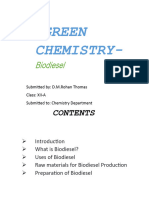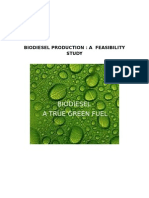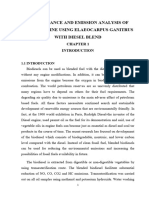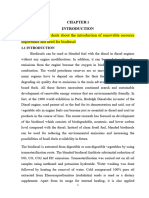What Is Biodiesel
What Is Biodiesel
Uploaded by
falobaitCopyright:
Available Formats
What Is Biodiesel
What Is Biodiesel
Uploaded by
falobaitOriginal Description:
Original Title
Copyright
Available Formats
Share this document
Did you find this document useful?
Is this content inappropriate?
Copyright:
Available Formats
What Is Biodiesel
What Is Biodiesel
Uploaded by
falobaitCopyright:
Available Formats
Fueling America Through Renewable Resources
BioEnergy
Biodiesel Defined
The use of vegetable oil as a fuel source in diesel engines is as old as the diesel engine itself. However, the demand to develop and utilize plant oils and animal fats as biodiesel fuels has been limited until recently. The technical definition of biodiesel is: The mono alkyl esters of long fatty acids derived from renewable lipid feedstock such as vegetable oils or animal fats, for use in compression ignition (diesel) engines (National Biodiesel Board, 1996). In simple terms, biodiesel is a renewable fuel manufactured from methanol and vegetable oil, animal fats, and recycled cooking fats (U.S. Department of Energy, 2006). The term biodiesel itself is often misrepresented and misused. Biodiesel only refers to 100% pure fuel (B100) that meets the definition above and specific standards given by the American Society of Testing and Materials (ASTM) International (D 6751) <http://www.biofuels.arc.ab.ca/Biofuels/ Specifications/ASTM+D+6751-03a/Default. ksi>. However, it is often used to describe blends of biodiesel with petroleum diesel. Such blends are generally referred to as B2, B5, B20, etc., where the number indicates the percent of biodiesel used. The most common method to produce biodiesel is through a process called transesterification, which involves altering the chemical properties of the oil by using methanol (Fangrui and Hanna, 1998). Transesterification of plant oils with methanol is a relatively simple process that yields high conversions with only glycerin as a byproduct.
Purdue extension
ID-337
What is Biodiesel?
Shawn P. Conley, Department of Agronomy Bernie Tao, Department of Agricultural and Biological Engineering Purdue University
One hundred pounds of plant oil is reacted with 10 pounds of methanol to yield 10 pounds of glycerin and 100 pounds of biodiesel. While the process is relatively straightforward, due to quality concerns, legal liability, and vehicle warranty restrictions, we strongly recommend that individuals not try to produce biodiesel fuels. The properties of biodiesel differ depending on the source of plant oil/fat source. This is mainly related to their chemical structure, such as the number of carbons and the number of double bonds in the hydrocarbon chain. For an explanation of these differences, see the Purdue Extension publication Biodiesel Quality: Is All Biodiesel Created Equal? (ID-338).
Benefits of Biodiesel
There are several significant advantages and limitations of using biodiesel to replace petroleum-based diesel (U.S. Department of Energy, 2006).
Fueling America Through Renewable Crops
BioEnergy
Soybean Yield (bu per acre)
What Is Biodiesel? ID-337
Table 1. Impact of Oil Content and Grain Yield on B100 (Gallons) Production per Acre ---------------Percent Oil----------------18 19 20
Gallons of Biodiesel per Acre of Soybeans
The gallons of biodiesel an Indiana soybean grower can produce per acre is based on two factors: 1) average yield (bushels per acre) --------Gallons of B100 per acre---------and 2) percent oil content. Because soybean 40 59.2 62.5 65.8 yield and oil content are influenced by both 45 66.6 70.3 74.0 genetic and environmental factors, we may 50 74.0 78.1 82.2 see significant year-to-year variability (Table 1). Fortunately, the relationship between 55 81.4 85.9 90.4 pounds of oil produced per acre and pounds 60 88.8 93.7 98.6 One gallon of biodiesel weighs 7.3 pounds. of biodiesel produced per acre is 1:1. This simple relationship allows us to make reasonable estimates as the soybean growing season progresses. Advantages
1
1. B100 can be produced from renewable, domestic resources. 2. B100 is energy efficient. (The total fossil fuel energy efficiency of biodiesel is 320% vs. 83% for petroleum diesel.) (National Biodiesel Board, 1998) 3. B100 can be used directly in most diesel engine applications. 4. B100 can reduce global warming and tailpipe emissions (-41%) (Hill, Nelson, Tilman, Polasky, & Tiffany, 2006). 5. B100 is nontoxic and biodegradable. 6. B100 is a good solvent and may clean out fuel line and tank sediments. (Note that this may result in fuel filter clogging during initial use.)
Conclusion
Though the implementation and use of biodiesel in the United States are significant steps forward, it is critical to understand that biodiesel is only a partial solution to our fuel problem. If we converted all U.S. soybean acres to biodiesel, we would only replace 6% of the U.S. demand for diesel (Hill, Nelson, Tilman, Polasky, & Tiffany, 2006). Therefore, we must continue to look towards new sources of fuel to decrease our reliance on petroleum-based fuels.
References
Fangrui, M.; Hanna. M. A. Biodiesel Production: A Review. Bioresource Technology 70. p. 1-15, (1998). Hill, J.; Nelson, E.; Tilman, D.; Polasky, S.; Tiffany. D. Environmental, Economic, and Energetic Costs and Benefits of Biodiesel and Ethanol Biofuels. PNAS. p. 11206-11210, (2006). National Biodiesel Board. Biodiesel Report. (March 1996). National Biodiesel Board. Summary of 1998 USDA/DOE Biodiesel Life Cycle Analysis <http://www.nbb.org/pdf_ files/fuelfactsheets/LifeCycle_Summary.PDF> U.S. Department of Energy. Biodiesel Handling and Use Guidelines. DOE/GO-102006-2288, (March 2006). Visit <http://www.ces.purdue.edu/bioenergy> for free, downloadable copies of all of the publications in the Purdue Extension BioEnergy series.
Limitations
1. B100 contains approximately 8% less energy per gallon. 2. B100 generally has a higher cloud and pour point (will freeze at a higher temp) than conventional diesel. 3. B100 is not compatible with some hose and gasket materials, which may cause them to soften, degrade, and rupture. 4. B100 is not compatible with some metals and plastics. 5. B100 may increase nitrogen oxide emissions. The most common method used to overcome the limitations of B100 is called blending. Blending biodiesel with diesel to produce B20 (20% biodiesel), B5 (5% biodiesel), and B1 (1% biodiesel) retains many of the advantages of biodiesel while overcoming some of its limitations.
Purdue Agriculture
This material may be available in alternative formats. 1-888-EXT-INFO http://www.ces.purdue.edu/new
NEW 12/06
It is the policy of the Purdue University Cooperative Extension Service, David C. Petritz, Director, that all persons shall have equal opportunity and access to the programs and facilities without regard to race, color, sex, religion, national origin, age, marital status, parental status, sexual orientation, or disability. Purdue University is an Affirmative Action institution.
You might also like
- Green Chemistry - BiodieselDocument21 pagesGreen Chemistry - Biodieselkavikumar venkatajalamNo ratings yet
- Alternate FuelsDocument14 pagesAlternate FuelsMohanRaju VenkatRajuNo ratings yet
- Project ReportDocument54 pagesProject Reportjadhavakshay610No ratings yet
- Biofuel: A Promising Alternative Renewable Energy ResourceDocument5 pagesBiofuel: A Promising Alternative Renewable Energy Resourcesanojk_2000No ratings yet
- Applications of BiofuelsDocument21 pagesApplications of BiofuelsSatish HSNo ratings yet
- BiodieselDocument21 pagesBiodieselAsiiimweNo ratings yet
- COMPLETE Book Chp. Biodiesel ConversionDocument15 pagesCOMPLETE Book Chp. Biodiesel Conversionshikha sumanNo ratings yet
- Report On BiodieselDocument32 pagesReport On BiodieselEmmanuelNo ratings yet
- BiodieselDocument12 pagesBiodieselAlfonso MartínezNo ratings yet
- Commonly Asked Questions: What Is Biodiesel?Document2 pagesCommonly Asked Questions: What Is Biodiesel?Puneet PriyangueNo ratings yet
- Chapter # 1: 1.1) What Is Biodiesel?Document125 pagesChapter # 1: 1.1) What Is Biodiesel?saqib sulmanNo ratings yet
- Exploitation of Oil-Bearing Microalgae For BiodieselDocument10 pagesExploitation of Oil-Bearing Microalgae For BiodieselJeevan KumarNo ratings yet
- Demirbas (2007)Document10 pagesDemirbas (2007)Laís C. PoletoNo ratings yet
- Biodiesel Feasibility Study by RicCapistranoDocument17 pagesBiodiesel Feasibility Study by RicCapistranobiodieselchemistdawNo ratings yet
- BiodieselDocument7 pagesBiodieselKrishna RavichandarNo ratings yet
- Ijaar Ste v4n6 Jun18 p46Document8 pagesIjaar Ste v4n6 Jun18 p4621DME26 Ravikant KumarNo ratings yet
- "Application of Biofuels in Automotives ": Visveswaraiah Technological University, BelgaumDocument23 pages"Application of Biofuels in Automotives ": Visveswaraiah Technological University, BelgaumharimadhavareddyNo ratings yet
- Use of Waste Vegetable Oil As BiodieselDocument11 pagesUse of Waste Vegetable Oil As BiodieselSherwin B. LutapNo ratings yet
- ICONICE 2007 Review On BiodieselDocument8 pagesICONICE 2007 Review On BiodieselKalyani RadhaNo ratings yet
- Edit ThesisDocument22 pagesEdit ThesisCj MoLanoNo ratings yet
- Biodiesel: Soy-Oil-Powered Public BusDocument8 pagesBiodiesel: Soy-Oil-Powered Public BusSrinivasan RaviNo ratings yet
- Biodiesel Production-Current State of The Art and ChallengesDocument10 pagesBiodiesel Production-Current State of The Art and ChallengesMaka MagnaretogneNo ratings yet
- My Presentation On Topic Bio DieselDocument24 pagesMy Presentation On Topic Bio DieselAnkesh Kunwar100% (1)
- Effect of Bioethanol On Engine PerformanDocument9 pagesEffect of Bioethanol On Engine PerformanMOHAMMAD KHAIRUL AKMAL BIN MOHD AZAM A21ET0094No ratings yet
- Nergy: Biodiesel Quality: Is All Biodiesel Created Equal?Document4 pagesNergy: Biodiesel Quality: Is All Biodiesel Created Equal?nicografiaNo ratings yet
- Seminar PDFDocument18 pagesSeminar PDFTabrez AlamNo ratings yet
- Biodiesel: Background and Information What Is Biodiesel?Document3 pagesBiodiesel: Background and Information What Is Biodiesel?Jaay Ell Esteban Alejandro0% (1)
- (Advantages of BiodieselDocument5 pages(Advantages of BiodieselYoussef KamounNo ratings yet
- ImpacDocument5 pagesImpacYoussef KamounNo ratings yet
- SadagobanDocument48 pagesSadagobanSolomon DurairajNo ratings yet
- 2001 Canakci Biodiesel ProductionDocument10 pages2001 Canakci Biodiesel ProductionLeanne MartinNo ratings yet
- Biodiesel As An Alternative Fuel For Direct Injection Diesel Engines: A ReviewDocument18 pagesBiodiesel As An Alternative Fuel For Direct Injection Diesel Engines: A Reviewmert tıglıNo ratings yet
- Energy MimiDocument18 pagesEnergy Mimiengineerusman219No ratings yet
- Bio Deisel Vs Petro DieselDocument8 pagesBio Deisel Vs Petro DieselchrisgargeNo ratings yet
- CIVIL BiodieselDocument15 pagesCIVIL Biodieselmd washiqeNo ratings yet
- Modifying Soybean Oil For Enhanced Performance in Biodiesel BlendsDocument11 pagesModifying Soybean Oil For Enhanced Performance in Biodiesel BlendsLudiele SiuchNo ratings yet
- Arunprasath 2Document48 pagesArunprasath 2Solomon DurairajNo ratings yet
- Biodiesel Refers To A Vegetable Oil-Or Animal Fat-Based Diesel Fuel Consisting of Long-Chain AlkylDocument12 pagesBiodiesel Refers To A Vegetable Oil-Or Animal Fat-Based Diesel Fuel Consisting of Long-Chain AlkylClaroslava FrancoNo ratings yet
- Alternate Fuels: S.D.M.College of Engineering and Technology DharwadDocument13 pagesAlternate Fuels: S.D.M.College of Engineering and Technology DharwadAarif MohdNo ratings yet
- Straight Vegetable Oil As A Diesel Fuel?: Vehicle Technologies OfficeDocument2 pagesStraight Vegetable Oil As A Diesel Fuel?: Vehicle Technologies OfficeRiko Rikardo SikumbangNo ratings yet
- Experimental Investigation of Waste Cooking Oil Biodiesel On Single Cylinder VCR CI EngineDocument18 pagesExperimental Investigation of Waste Cooking Oil Biodiesel On Single Cylinder VCR CI EnginePrashant MurgeNo ratings yet
- Biodiesel: An Alternative To Conventional Fuel: Energy ProcediaDocument12 pagesBiodiesel: An Alternative To Conventional Fuel: Energy ProcediaAkash DeepNo ratings yet
- Team Sustain Limited: CochinDocument3 pagesTeam Sustain Limited: CochinMuttithodathil Thomas ThomasNo ratings yet
- Paper Presentation Report: Anjalai Ammal Mahalingam Engineering CollegeDocument15 pagesPaper Presentation Report: Anjalai Ammal Mahalingam Engineering CollegeManjesh ThilakNo ratings yet
- ARUNPRASATHDocument48 pagesARUNPRASATHSolomon DurairajNo ratings yet
- Final Biodiesel PaperDocument4 pagesFinal Biodiesel Papernavri_nalhadNo ratings yet
- InTech Animal fatVIVIAN FEDERN Wastes For Biodiesel ProductionDocument26 pagesInTech Animal fatVIVIAN FEDERN Wastes For Biodiesel Productionqyyhtpmcp6No ratings yet
- Alternative Transportation Fuels (Ethanol)Document14 pagesAlternative Transportation Fuels (Ethanol)NGUYÊN LÊ KHÁNHNo ratings yet
- Chapter I III Group 4Document37 pagesChapter I III Group 4Andrea Gienel MontallanaNo ratings yet
- Ijert Ijert: "Characterization of Biodiesel: A Review"Document6 pagesIjert Ijert: "Characterization of Biodiesel: A Review"Siraj SayyedNo ratings yet
- Environmental Building News: BiodieselDocument10 pagesEnvironmental Building News: BiodieselOscar GarridoNo ratings yet
- The Synthesis of Biodiesel From Vegetable OilDocument6 pagesThe Synthesis of Biodiesel From Vegetable OilAlex FaudoaNo ratings yet
- Economic Cost Analysis of Biodiesel Production: Case in Soybean OilDocument9 pagesEconomic Cost Analysis of Biodiesel Production: Case in Soybean OilAnonymous jqevOeP7No ratings yet
- Development of BiodieselsDocument9 pagesDevelopment of BiodieselsARJYA ROYNo ratings yet
- Biodiesel Refers To A Non-Petroleum-Based Diesel Fuel Consisting of ShortDocument12 pagesBiodiesel Refers To A Non-Petroleum-Based Diesel Fuel Consisting of Shortchoureyshishir73No ratings yet
- 1 s2.0 S036054421400334X MainDocument11 pages1 s2.0 S036054421400334X MainDimaz Iyas ArmezyNo ratings yet
- 1.1 Applications of BiodieselDocument14 pages1.1 Applications of BiodieselTabrez AlamNo ratings yet
- Biodiesel Production101: Homebrew Edition: A Do It Yourself Guide to Produce Biodiesel on Your BackyardFrom EverandBiodiesel Production101: Homebrew Edition: A Do It Yourself Guide to Produce Biodiesel on Your BackyardNo ratings yet
- Physical Chemistry Level 2 LabDocument34 pagesPhysical Chemistry Level 2 LabfalobaitNo ratings yet
- Learner Centered TeachingDocument39 pagesLearner Centered TeachingKlaribelle Villaceran50% (2)
- Making Chemistry Fun To LearnDocument5 pagesMaking Chemistry Fun To LearnLeela JayabalanNo ratings yet
- Ethanol and Internal Combustion EnginesDocument20 pagesEthanol and Internal Combustion EnginesfalobaitNo ratings yet
- Ethanol Internal Combustion EnginesDocument6 pagesEthanol Internal Combustion EnginesfalobaitNo ratings yet
- Excited States and Electronic Spectroscopy - Edward C. Lim Notes2008Document26 pagesExcited States and Electronic Spectroscopy - Edward C. Lim Notes2008falobaitNo ratings yet
- Gaussian 03 ManualDocument592 pagesGaussian 03 ManualfalobaitNo ratings yet
- Effective Core Potential - by DolgDocument35 pagesEffective Core Potential - by DolgfalobaitNo ratings yet



































































